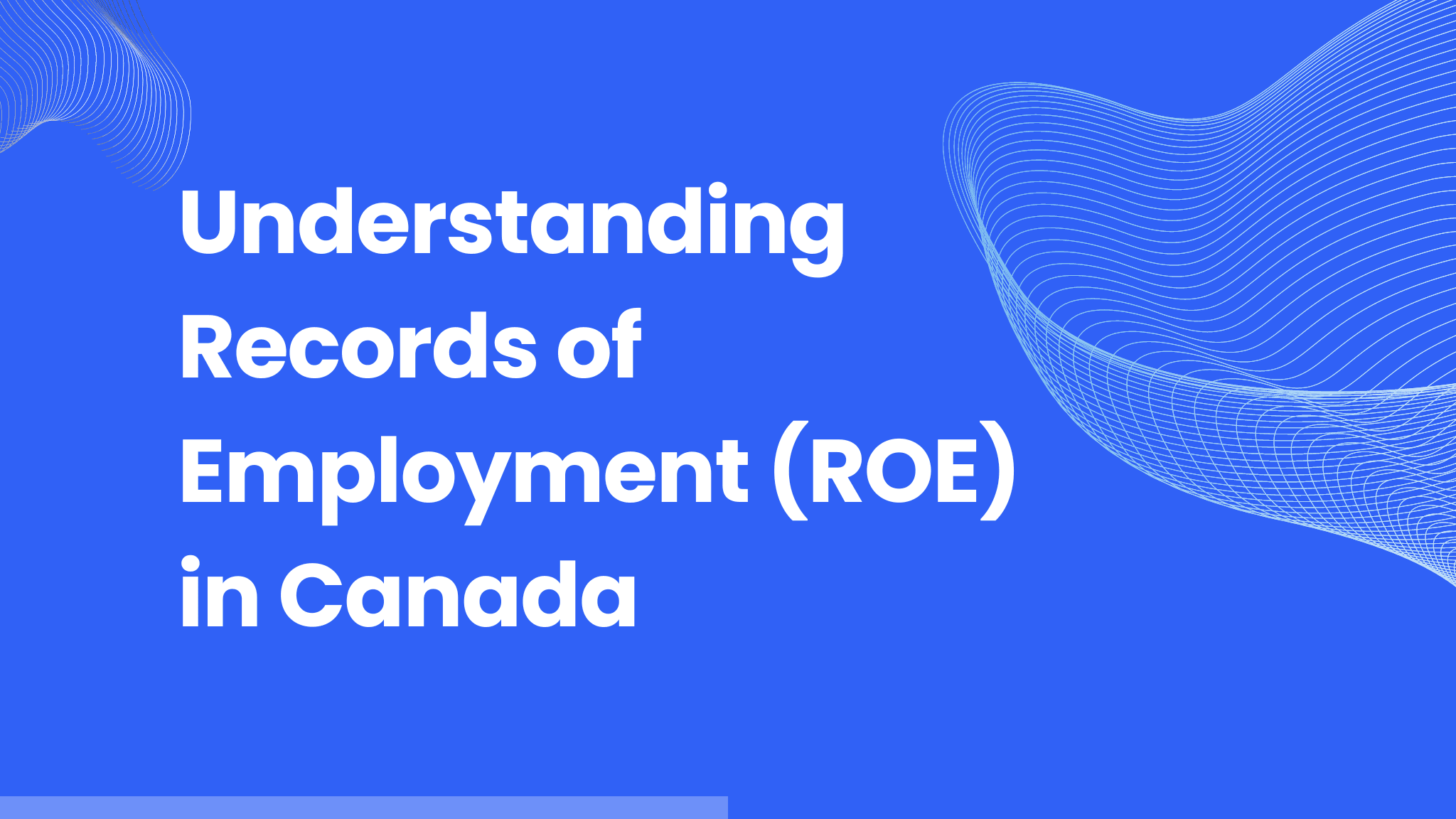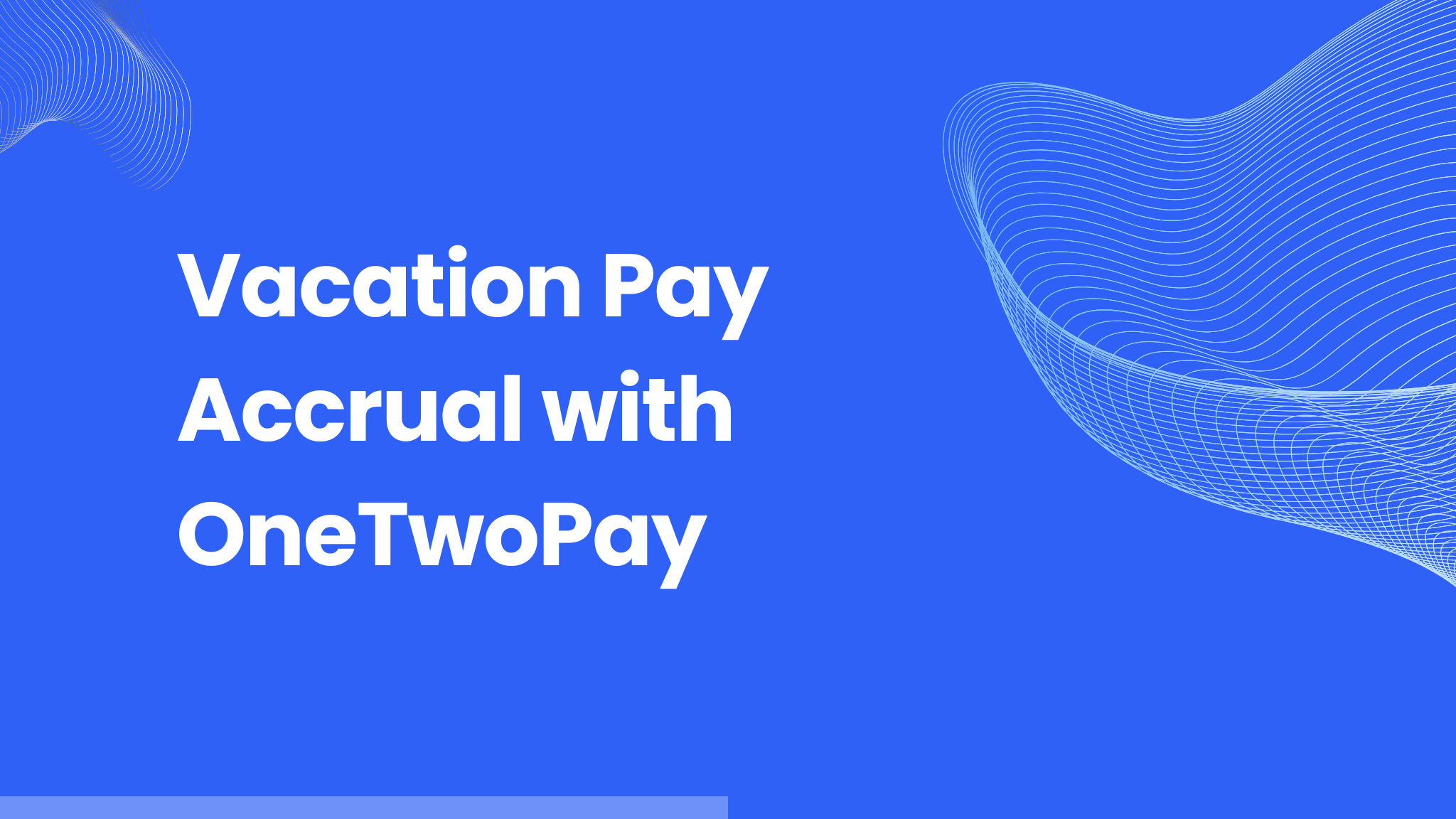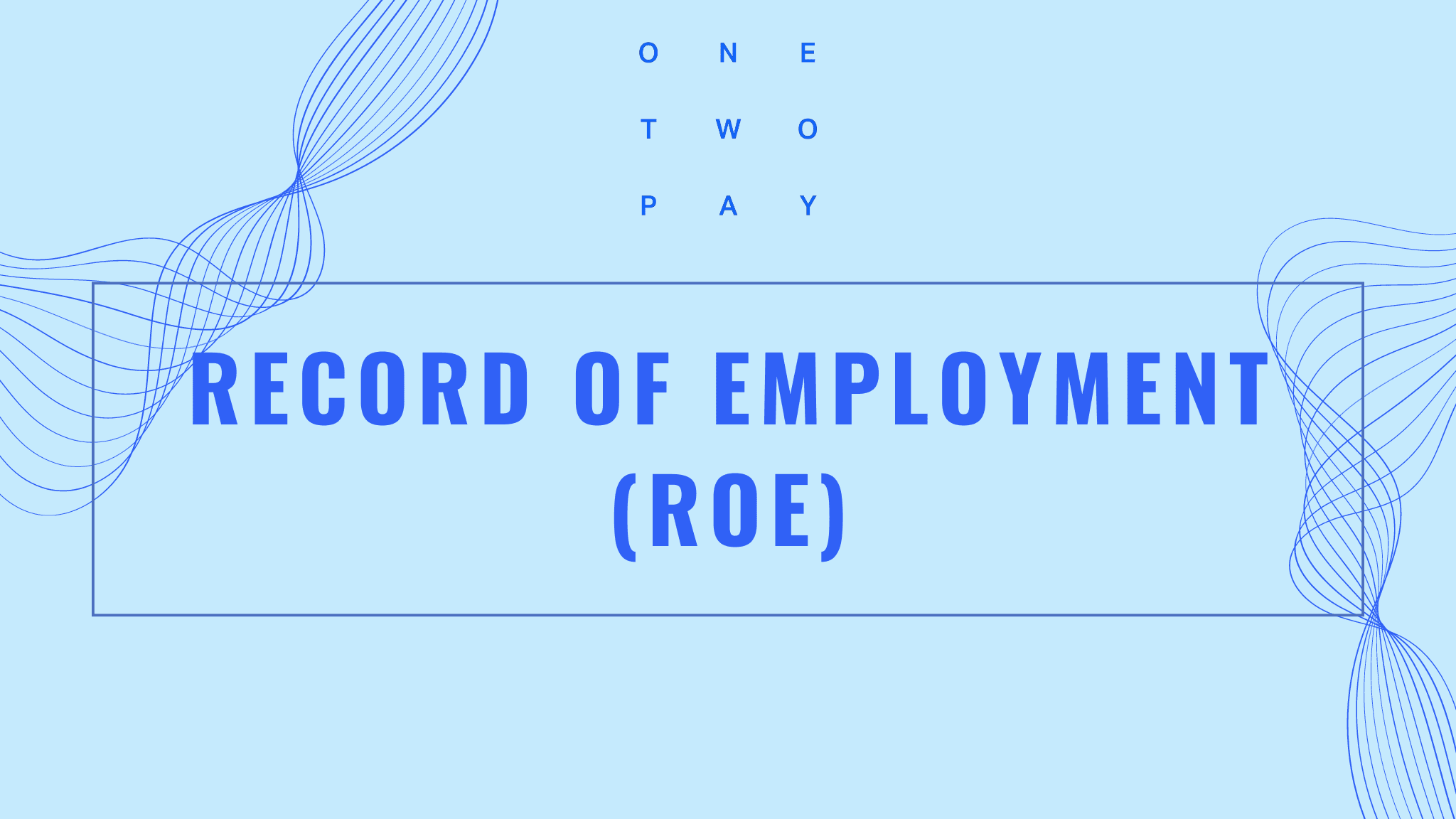
Understanding Records of Employment (ROE) in Canada
Records of Employment are essential reports to be aware of as both an employer and an employee. Whether you’re an employer managing your company’s payroll or an employee preparing for changes in your professional journey, ROE is an important document that holds significant weight. This guide delves into the details of ROE in Canada, from its basic principles to its recent integration into our platform here at OneTwoPay.
What is a Record of Employment (ROE)?
A Record of Employment (ROE) is an official document issued by employers to employees and to Service Canada when their earnings are interrupted. This interruption can come from various situations such as layoffs, resignations, maternity leaves, or even when an employee is still employed but experiences a significant change in their employment status or earnings. In its simplest form, an ROE is a document that is used by Service Canada to determine someone’s eligibility for Employment Insurance (EI).
It’s the single most important document regarding Canada’s EI program. Employers must issue ROEs each time an employee receiving insurable earnings experiences an interruption in earnings. Even if an employee doesn’t plan on applying for EI, the employer still must issue the ROE to Service Canada.
Once Service Canada receives the document, they will use the information to determine whether the person is eligible for EI benefits, how much they can receive, and how long they are eligible to access those benefits.
What is Service Canada?
Service Canada is a government service that provides access to essential programs like employment insurance, pensions, and benefits for seniors. It's separate from the CRA, which deals with taxes. Canadians can access Service Canada online through their account, making it convenient to handle these services without visiting multiple offices. Essentially, it's a centralized hub for important government assistance programs, streamlining the process for citizens.
So, whether you're looking for help with job-related matters, planning for retirement, or accessing benefits for seniors, Service Canada is there to assist. It simplifies the process by offering a single point of access for various government programs, making it easier for Canadians to navigate and use these essential services.
As an Employee, Why Do I Need a Record of Employment?
Your record of employment serves as proof of your employment history and earnings, which is crucial for accessing government benefits like employment insurance (EI) in case you lose your job and need temporary financial assistance. The ROE helps ensure that you receive the correct amount of EI benefits if you become unemployed.
Whether you’re experiencing an unexpected interruption in earnings from something such as a layoff or an injury or your earnings have been interrupted due to something planned such as a maternity leave, your ROE is a critical document that will help Service Canada confirm your eligibility for benefits and issue the funds you’re qualified to receive. It’s important to note that not all earnings are eligible for government benefits such as EI, so you’ll want to plan accordingly to ensure you’re covered if your income should shift.
Why Do Employers Need to Issue Records of Employment?
Service Canada relies on the information provided in the ROE to assess whether an individual qualifies for benefits. This ensures that EI benefits are distributed accurately and prevents misuse or false claims.
Additionally, issuing ROEs is a requirement for employers, mandated by Service Canada. Regardless of whether an employee intends to claim EI benefits, employers must complete and file an ROE for any employee experiencing a lapse in earnings. Maintaining accurate ROE records is crucial as Service Canada retains them for 11 years, emphasizing the importance of providing correct and up-to-date information. Ultimately, issuing ROEs is not only necessary for complying with government regulations but also ensures that employees receive the support they need during periods of income interruption.
When Does a Record of Employment Need to be Issued?
A Record of Employment (ROE) needs to be issued when an employee's earnings are interrupted, as defined by specific criteria set by Service Canada. This interruption typically occurs when an employee experiences a lapse in compensation for seven consecutive calendar days, known as the seven-day rule, with no work and no insurable earnings. Circumstances leading to an interruption of earnings can include an employee quitting, being laid off, or being terminated from their position. Additionally, if an employee's insurable earnings fall below 60% of their regular wages due to various reasons such as injury, illness, quarantine, pregnancy, or caregiving responsibilities, it qualifies as an interruption of earnings.
There are exceptions to the criteria for an interruption of earnings. For instance, certain professions like real estate agents and employees with non-standard work schedules, such as firefighters or healthcare workers, may have different rules regarding interruptions of earnings. Additionally, commission-based salespeople may have unique circumstances that exempt them from the standard criteria. In most cases where there is a significant break in an employee's compensation, issuing a Record of Employment is necessary to comply with Service Canada regulations and ensure accurate reporting of employment information.
There are some special circumstances that also necessitate the issuance of an ROE:
If Service Canada requests an ROE. This would likely take place if an employee is working two jobs and experiences an interruption of earnings in one of them. In this case, both employers, even the current employer, would need to issue an ROE so Service Canada can properly understand the person’s earnings if they apply for benefits.
When the pay period type changes.
If an employee is still employed with the same company but is transferred to another Canada Revenue Agency Payroll Account Number.
When there is a change in ownership.
When an employer declares bankruptcy.
For wage-loss insurance (WLI) plan payments.
There are a few more special circumstances that may require an ROE to be issued. Usually, it’s good practice to look into the specific employment and payment types of an employee to ensure you are providing ROEs in all necessary circumstances.
Who Can Get an ROE?
Employers are required to issue Records of Employment (ROEs) only for employees who receive insurable earnings and work insurable hours. If there's uncertainty regarding whether an employee's earnings and hours are insurable, contacting the Canada Revenue Agency for an insurability ruling is recommended. Independent contractors, however, do not fall under the scope of ROE issuance.
As an employer, it's your responsibility to provide an ROE when an employee's work comes to an end and there's an interruption of earnings. This includes situations where the employee is dismissed, laid off, quits, or retires. ROEs are not necessary for part-time, on-call, or casual workers, nor are they required for independent contractors upon the conclusion of a service contract.
What Information is on an ROE?
Primarily, the ROE includes basic details about the employer, such as their name, address, and Canada Revenue Agency Business Number. Similarly, it provides pertinent information about the employee, including their name, address, and Social Insurance Number. Furthermore, the ROE outlines critical details regarding the interruption of earnings, including the employee's first day of work, the last day they were paid, and the final pay period ending date.
The ROE specifies the employee's total insurable earnings and hours, which are crucial factors in determining EI eligibility. Additionally, it delineates the reason for issuing the ROE, whether due to dismissal, layoff, resignation, or other circumstances leading to an interruption of earnings. Finally, the document is certified by the employer's authorized signatory, typically a payroll administrator, affirming the accuracy of the information provided. This comprehensive data on the ROE ensures clarity and accuracy in Service Canada's processing of EI claims.
How to Get a Record of Employment?
The issuance of a Record of Employment (ROE) varies depending on whether it is provided in paper format or electronically. When employers issue ROEs on paper, they must do so within five calendar days of the first day of an interruption of earnings or the day they become aware of the interruption. Paper ROE forms need to be ordered from Service Canada. Each form comes with a serial number and comes in triplicate. There is the original and two carbon copies. The original is given to the employee, one copy is submitted to Service Canada, and the employer keeps the second carbon copy. In this case, the employer provides the employee Part 1 (the original) of the paper ROE. The employee is then responsible for submitting this original copy to Service Canada when applying for EI benefits, either by uploading it online, mailing it, or dropping it off in person at a Service Canada Centre.
On the other hand, when employers issue ROEs electronically, the timeline differs based on the pay period type. If the pay period is weekly, biweekly, or semi-monthly, employers have up to 5 calendar days after the end of the pay period in which the interruption of earnings occurred to issue the electronic ROE. However, if the pay period is monthly or occurs every four weeks, electronic ROEs must be issued within five calendar days after the end of the pay period or within 15 calendar days after the first day of the interruption of earnings, whichever comes first.
In the case of paper ROEs, the employer provides Part 1 to the employee, sends Part 2 to Service Canada, and retains Part 3 for their records. Conversely, when issuing electronic ROEs, employers submit the ROE electronically to Service Canada either through ROE Web using compatible payroll software, manually entering data online through Service Canada's website, or through Secure Automated Transfer (SAT) performed by a payroll service provider using bulk transfer technology. The employee can then access their ROE online through Service Canada.
How to Create a Record of Employment
Creating an ROE manually can be a complex and time-consuming process. However, with the advancement of technology, online payroll platforms like OneTwoPay have simplified this process. To create an ROE manually, you need to gather all the relevant information, including the employee's personal details, employment history, earnings, and the reason for the interruption in earnings. Once you have compiled all the necessary information, you can fill out the ROE form provided by Service Canada and submit it to the employee.
Alternatively, OneTwoPay offers an automated solution to create and manage ROEs, streamlining the entire process and ensuring accuracy and compliance.
How to Access Your Record of Employment as an Employee
Accessing your ROE is a straightforward process. If your employer has provided you with a paper copy of the ROE, you can simply keep it in a safe place for your records. To apply for benefits, you will need to submit it to Service Canada yourself. If you prefer a digital copy, you can request an electronic version from your employer or download it directly from Service Canada's online portal after it has been submitted electronically by your employer.
To download your ROE from the Service Canada portal:
Log in to your Service Canada account.
Navigate to the “View my current and past claims” section.
Select the ROE you wish to view or download.
Records of Employment (ROE) With OneTwoPay
Attention OneTwoPay users: Did you know that you can easily generate ROEs for free within our platform? Our system seamlessly pulls from your pay stub data, enabling you to quickly and effortlessly create ROEs. Our system simplifies the process by directly producing an XML file in Service Canada's required format from your OneTwoPay account. You can review and edit employee data before generating the file, ensuring compliance with Service Canada's criteria. Plus, our platform integrates Service Canada's validations, providing immediate feedback. Once uploaded, you can access a PDF version for your records. Learn more.



